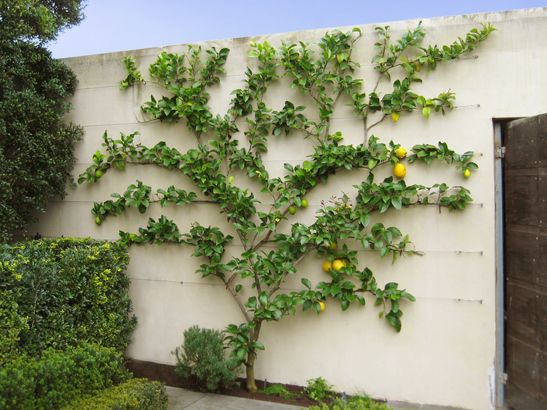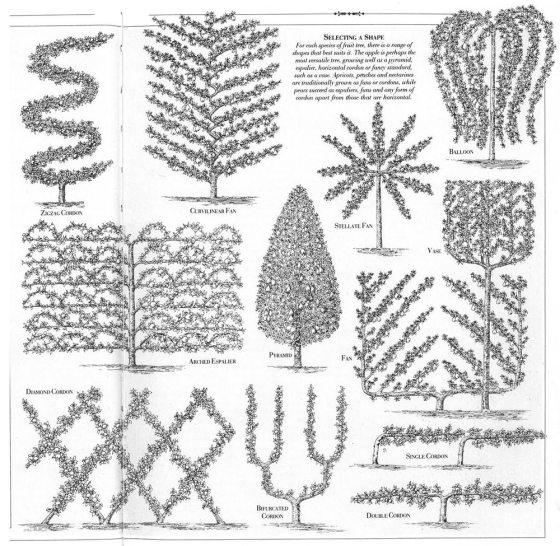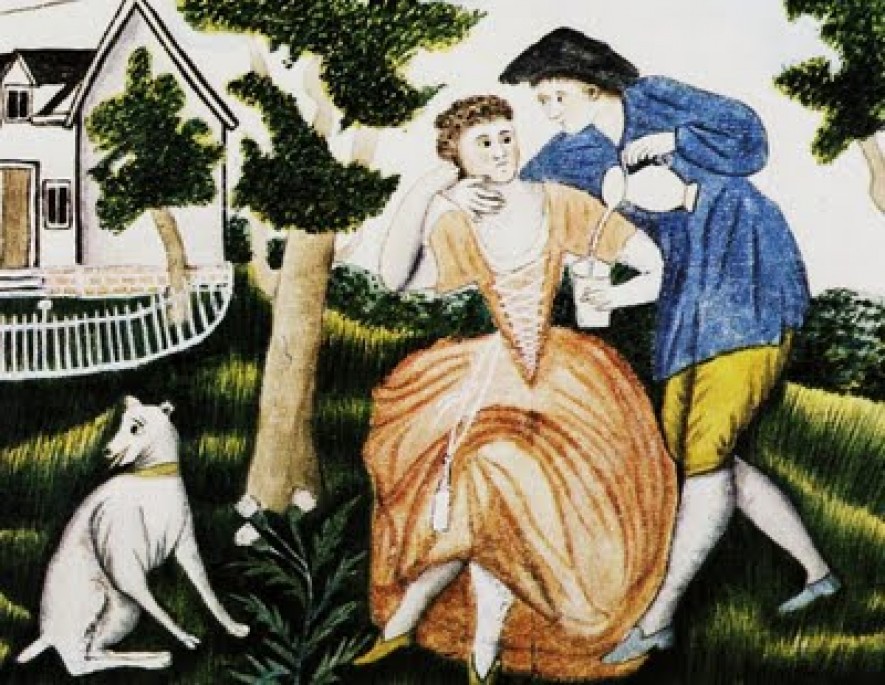My own garden is finally, after almost fourteen years living here, and one year since he builders wreaked their havoc, starting to look more mature and take shape. My priority was to get some permanent planting established – trees, shrubs and evergreens – to give it year-round interest and create some privacy (vital in a town garden), structure and refuge for birds and wildlife. The problem with this is that large shrubs and trees, apart from sapping nutrients from the soil, create shade and take up valuable space. What I have done, and am continuing to do, with young shrubs is to create a sort of lollipop effect. If you trim out all of the lower branches and side shoots, you can turn almost any evergreen shrub into a standard. This means that you create light and valuable space underneath, where you can continue to grow flowering plants. You can get really creative and topiarise evergreens into various shapes to suit. I have (admittedly a rather cack-handed-looking) sort of umbrella and a large ball of laurel (Prunus laurocerasus) on top of bare stems about one metre tall, cones, balls and squares of box (Buxus sempervirens) and am working on cloud pruning a holly (Ilex aquifolioum). Cloud pruning refers to a technique whereby you thin out the branches of the plant to a few good strong leaders pointing in various directions and create puffy cloud-like balls of foliage at the end of each. The benefits of pruning and shaping plants can really be seen in winter, when the garden is bare and the herbaceous plants have died back. The structure and various shapes give interest and look far less boring than a few blobs of untidy greenery. Take a look now at what you have growing around and underneath your shrubs and small trees, and take out a loppers to give them space to grow. Versailles it is not, but maybe I can aspire to the Petit Trianon!
Tag Archives: pruning
Coppicing for better winter colour
Coppicing refers to pruning shrubs and some trees close to the base of the plant. Late winter is the best time to coppice and pollard. It promotes colourful young stems, ornamental foliage and rejuvenates plants that tolerate hard pruning.
Coppicing is used to ensure that willows and dogwoods produce a fresh crop of bright coloured stems each winter. It is also a good way to rejuvenate an old shrub which is no longer performing well or has become messy in appearance. To coppice just take a deep breath and cut stems to within 5cm-7.5cm (2in-3in) of the ground, or to last year’s stubs. Do this before new leaves appear in March.
Shrubs and trees suitable for Coppicing
- Acer pensylvanicum‘Erythrocladum’
- Beech (Fagus sylvatica)
- Dogwoods (Cornus), including Cornus sanguinea‘Midwinter Fire’, and alba ‘Elegantissima’
- Elder (Sambucus)
- Foxglove tree (Paulownia)
- sericea ‘Flaviramea’ Sweet gum (Eucalyptus gunnii)
- Hazel (Corylus)
- Hornbeam (Carpinus)
- Indian bean tree (Catalpa)
- Judas tree (Cercis)
- Lime (Tilia)
- Ornamental bramble (Rubus cockburnianus)
- Smoke bush (Cotinus)
- Toona sinensis‘Flamingo’
- Tree of heaven (Ailanthus altissima)
- Willows (Salix), including Salix albavitellina ‘Britzensis’, S. viminalis and S. daphnoides
- Yew (Taxus)


Pleaching trees for a formal garden


Pleaching is a more glamorous use of the skills needed for hedge laying for stock control. This technique is used to create a formal hedge on stilts. Suitable trees are standardised by removing their lower branches and the remaining branches are entwined with those of the tree beside it.
As with espaliers you can now buy trees which have been ready-pleached; the branches of these are trees have already started to be trained and are tied to a bamboo frame. In order to create a formal hedge on stilts you need to plant your trees in an evenly spaced row. Pleaching is not for the faint hearted as it is extremely labour intensive. You need to constantly tie in new stems to the tree’s neighbours, prune regularly and loosen ties which have become too tight.
When to pleach
Always select young, whippy plants that are more easily trained for any pleaching.
Plant in winter and during the early years also prune in the winter when the plants are leafless and dormant.
Train and tie new shoots in over the summer.
Once pleached trees have reached their full extent, prune in the summer, pruning to shape the tree growth and reduce its vigour.
How to pleach
Plant trees in single or parallel rows 1.2m (4ft) apart in the row and at the same spacing between parallel rows
Allow 2.4-3m (8-10ft) between rows to provide a pathway
During the spring and summer growing season, tie in new shoots to the supports. Horizontal stems should be plaited or tied in with those of neighbouring trees
Unnecessary or ungainly shoots should be pruned back to one or two buds from the base during early autumn or winter. Pinch out leading growths to encourage bushiness.
Trees suitable for pleaching
- Generally trees used for pleaching are deciduous. The most suitable evergreen for pleaching is the evergreen oak (Quercus ilex).
- Lime (Tilia) platyphyllos ‘Rubra’ T. x europea ‘Pallida’
- Hornbeam (Carpinus betulus)
- London Plane (Platanus x acerifolia)
How to Espalier a fruit tree
T
 he practice of espaliering fruit trees was brought to Ireland in the seventeenth century by Huguenots fleeing persecution in France. Training apples and pears as espaliers, not only saves space in the garden but also ensures a good crop, keeps trees fairly disease free and creates a good architectural vertical feature in the garden.
he practice of espaliering fruit trees was brought to Ireland in the seventeenth century by Huguenots fleeing persecution in France. Training apples and pears as espaliers, not only saves space in the garden but also ensures a good crop, keeps trees fairly disease free and creates a good architectural vertical feature in the garden.
The espalier method means growing a fruit tree or ornamental shrub while training its branches to grow flat against a wall, supported on a lattice or strong wire.
When planning to grow a tree as an espalier, make sure you buy one on one of the following rootstocks, this can be complicated so ask in your nursery for advice when buying a tree. Pears trees are generally grafted onto quince stock. You can often buy trees with one to three tiers already formed or grown from one-year-old trees.
Planting and initial training
Firstly you need to establish a training system against a wall or fence. Erect horizontal wires 35-45cm (15-18in) apart between posts, or straining ‘eyes’ on walls or fences.
Trees should be planted 3.75m-6m (12-20ft) apart, according to their vigour.
When planting a new ‘unfeathered maiden’ – garden parlance for a one-year-old tree with no side shoots, cut back the main stem to 30cm (1ft) from the ground
Allow the top three buds to grow out in spring, train the top one vertically up a cane, the others two to canes at 45 degrees to the main stem. In November, lower them carefully until they are horizontal, tying them in with soft twine
Cut back the vertical stem to within 45cm (18in) or the lower arms, leaving two buds to form the next horizontal layer and the top bud to form the new leader. If growth is weak, prune back the horizontal branches by one-third to downward facing buds
The following year train the second tier in the same way as the first. Cut back competing growths on the main stem and side shoots from the horizontal arms back to three leaves above the basal cluster
Repeat the process until the trees have produced their final tier and grown horizontally to fill their allotted space. Then allow two shoots to grow, tie them to the top wire and cut them back to within 2.5cm (1in) of their base the following winter
Remove the blossom in spring, for the first three years, so all of the energy goes into plant growth.
Prune trees after fruiting by cutting back the side-shoots growing from the horizontal leaders to three leaves from the basal cluster, 7.5cm (3in) long. Shoots from previously pruned side shoots should be cut back to one leaf from the basal cluster, 2.5cm (1in) long
If any secondary growths arise after this pruning, cut them back to the base in September. Side-shoots on the vertical stem are best removed completely
Clusters of fruit buds may need to be thinned after seven or eight years of ‘spur thinning’, alternatively, a few can be done each year in the dormant season (November to March), reducing over-complicated spur systems to one or two fruit buds.
Trees and shrubs suitable for espaliering
- Pears
- Cercis
- Laburnum
- Crepe Myrtle (Lagerstroemiae)
- Apples
- Parrotia persica
- Flowering almond, Apricot, cherry, peach, plum (Prunus)
- Cotoneaster
- Pyracantha
Another year over & a new one just begun……

This gallery contains 9 photos.
During the past two weeks I have been working in the garden for the first time this year – and in fact for the first time since late summer. In autumn, when I should have been toiling, I was far … Continue reading
